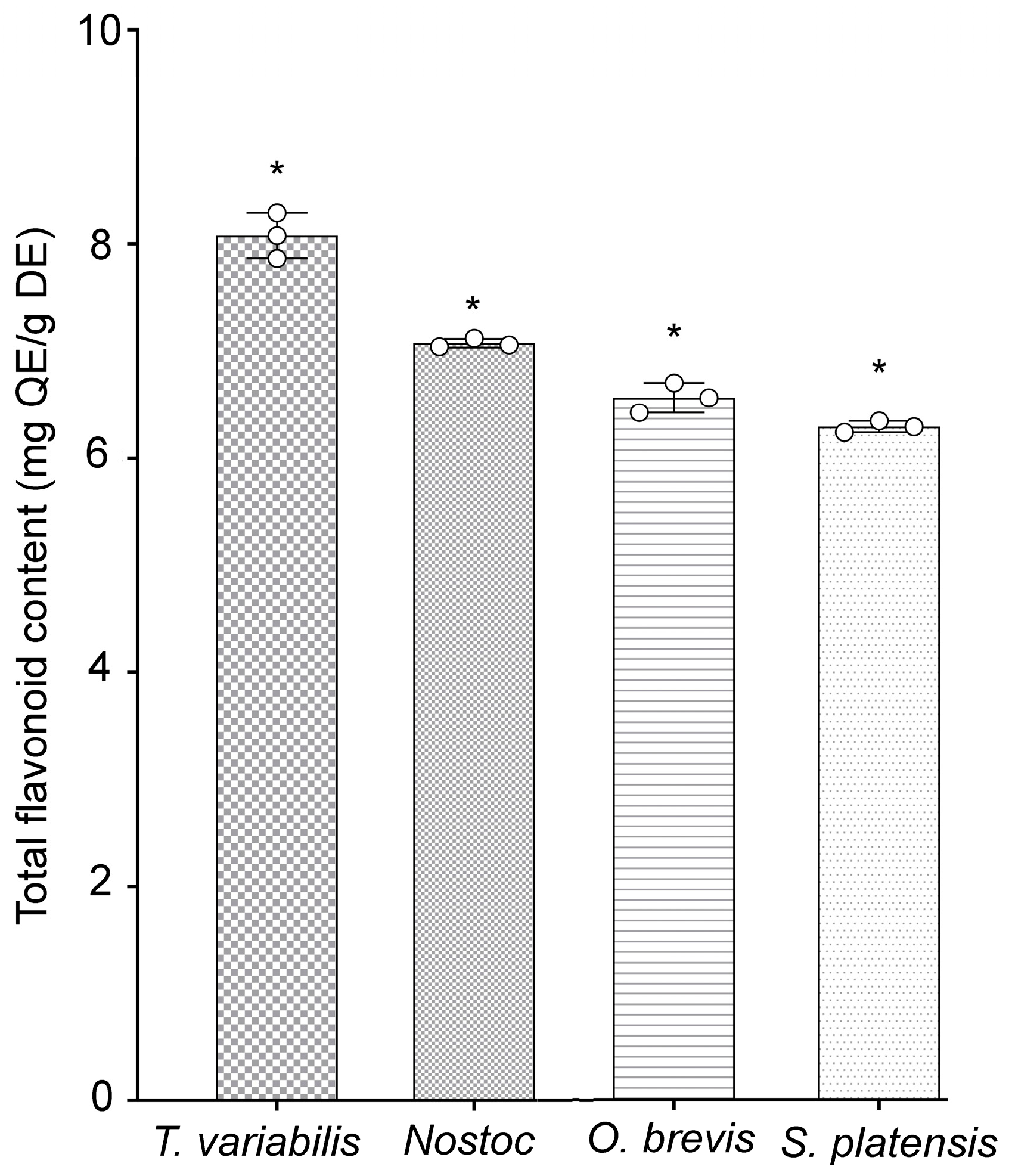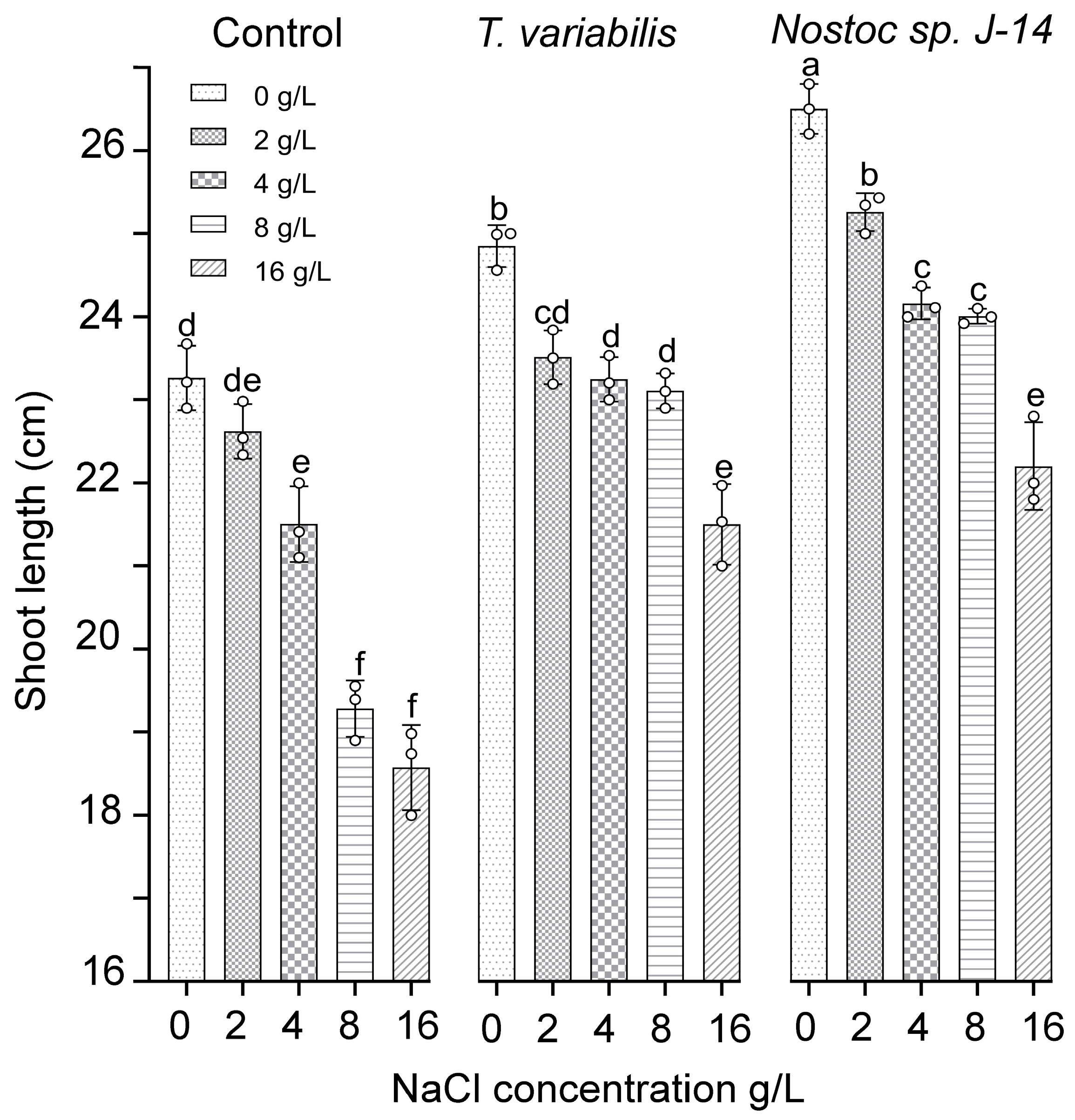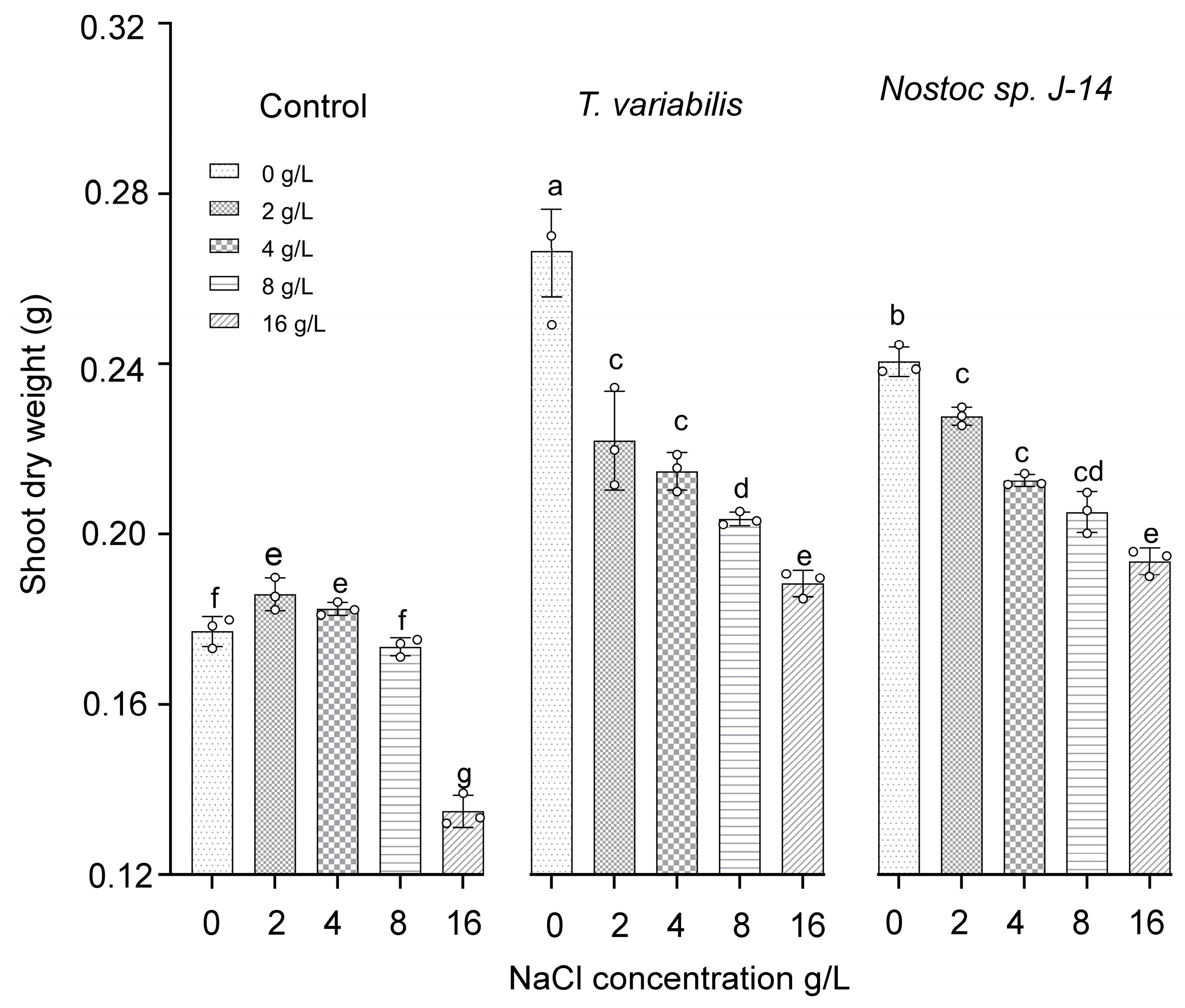Assessing the Efficacy of Cyanobacterial Strains as Oryza sativa Growth Biostimulants in Saline Environments
Abstract
1. Introduction
2. Results
2.1. Antioxidant Activity of the Examined Cyanobacterial Strains
2.2. Effects of Different NaCl Concentrations on Cyanobacterial Culture Growth
2.3. Growth-Stimulating Activity of the Tested Strains
3. Discussion
4. Materials and Methods
4.1. Biological Materials
4.2. The Cultivation of and Biomass Production by Microorganisms
4.3. Preparation of Supernatants and Cell Extracts for Determination of Antioxidant Properties
4.4. Analysis of Antioxidant Activity
4.4.1. DPPH Free Radical Scavenging Activity Assay
4.4.2. Analysis of ABTS Cation Radical Scavenging Activity
4.4.3. Analysis of β-Carotene–Linoleic Acid
4.4.4. Copper Ion-Reducing Antioxidant Capacity Assay
4.4.5. Ferric Reducing Antioxidant Power Assay
4.4.6. Analysis of Total Flavonoid Content
4.5. Effect of Different NaCl Concentrations on the Survival Rate of Cyanobacteria
4.6. Determining the Growth-Stimulating Properties of Selected Cyanobacterial Strains in Saline Soil
- (1)
- Soil soaked with T. variabilis K-31;
- (2)
- Soil soaked with Nostoc sp. J-14;
- (3)
- Soil soaked with water.
4.7. Statistical Analysis
5. Conclusions
Author Contributions
Funding
Data Availability Statement
Conflicts of Interest
References
- Hamad, H.S.; Bleih, E.M.; Gewaily, E.E.; Abou Elataa, A.E.; El Sherbiny, H.A.; Abdelhameid, N.M.; Rehan, M. Cyanobacteria Application Ameliorates Floral Traits and Outcrossing Rate in Diverse Rice Cytoplasmic Male Sterile Lines. Plants 2022, 11, 3411. [Google Scholar] [CrossRef] [PubMed]
- Rodríguez Coca, L.I.; García González, M.T.; Gil Unday, Z.; Jiménez Hernández, J.; Rodríguez Jáuregui, M.M.; Fernández Cancio, Y. Effects of Sodium Salinity on Rice (Oryza sativa L.) Cultivation: A Review. Sustainability 2023, 15, 1804. [Google Scholar] [CrossRef]
- Shrivastava, P.; Kumar, R. Soil Salinity: A Serious Environmental Issue and Plant Growth Promoting Bacteria as One of the Tools for Its Alleviation. Saudi J. Biol. Sci. 2015, 22, 123–131. [Google Scholar] [CrossRef] [PubMed]
- Mutale-joan, C.; Rachidi, F.; Mohamed, H.A.; Mernissi, N.E.; Aasfar, A.; Barakate, M.; Mohammed, D.; Sbabou, L.; Arroussi, H.E. Microalgae-Cyanobacteria–Based Biostimulant Effect on Salinity Tolerance Mechanisms, Nutrient Uptake, and Tomato Plant Growth under Salt Stress. J. Appl. Phycol. 2021, 33, 3779–3795. [Google Scholar] [CrossRef]
- Sebnem, K.; Sevinç, K.; Ellialtioglu, S.S. Antioxidant Enzyme Activities and Abiotic Stress Tolerance Relationship in Vegetable Crops. In Abiotic and Biotic Stress in Plants; Arun, K.S., Chitra, S., Eds.; IntechOpen: Rijeka, Yugoslavia, 2016; p. 21. [Google Scholar]
- Zhang, G.; Bai, J.; Zhai, Y.; Jia, J.; Zhao, Q.; Wang, W.; Hu, X. Microbial Diversity and Functions in Saline Soils: A Review from a Biogeochemical Perspective. J. Adv. Res. 2024, 59, 129–140. [Google Scholar] [CrossRef]
- Nawaz, T.; Saud, S.; Gu, L.; Khan, I.; Fahad, S.; Zhou, R. Cyanobacteria: Harnessing the Power of Microorganisms for Plant Growth Promotion, Stress Alleviation, and Phytoremediation in the Era of Sustainable Agriculture. Plant Stress 2024, 11, 100399. [Google Scholar] [CrossRef]
- Ilangumaran, G.; Smith, D.L. Plant Growth Promoting Rhizobacteria in Amelioration of Salinity Stress: A Systems Biology Perspective. Front. Plant Sci. 2017, 8, 1768. [Google Scholar] [CrossRef]
- Gaysina, L.A.; Saraf, A.; Singh, P. Chapter 1–Cyanobacteria in Diverse Habitats; Mishra, A.K., Tiwari, D.N., Rai, A.N., Eds.; Academic Press: Cambridge, MA, USA, 2019. [Google Scholar]
- Kalita, N.; Baruah, P.P. Cyanobacteria as a Potent Platform for Heavy Metals Biosorption: Uptake, Responses and Removal Mechanisms. J. Hazard. Mater. Adv. 2023, 11, 100349. [Google Scholar] [CrossRef]
- Rocha, F.; Esteban Lucas-Borja, M.; Pereira, P.; Muñoz-Rojas, M. Cyanobacteria as a Nature-Based Biotechnological Tool for Restoring Salt-Affected Soils. Agronomy 2020, 10, 1321. [Google Scholar] [CrossRef]
- Abinandan, S.; Subashchandrabose, S.R.; Venkateswarlu, K.; Megharaj, M. Soil Microalgae and Cyanobacteria: The Biotechnological Potential in the Maintenance of Soil Fertility and Health. Crit. Rev. Biotechnol. 2019, 39, 981–998. [Google Scholar] [CrossRef]
- Zhang, W.; Feng, Y. Characterization of Nitrogen-Fixing Moderate Halophilic Cyanobacteria Isolated from Saline Soils of Songnen Plain in China. Prog. Nat. Sci. 2008, 18, 769–773. [Google Scholar] [CrossRef]
- Akmukhanova, N.R.; Leong, Y.K.; Seiilbek, S.N.; Konysbay, A.; Zayadan, B.K.; Sadvakasova, A.K.; Sarsekeyeva, F.K.; Bauenova, M.O.; Bolatkhan, K.; Alharby, H.F.; et al. Eco-Friendly Biopesticides Derived from CO2-Fixing Cyanobacteria. Environ. Res. 2023, 239, 117419. [Google Scholar] [CrossRef] [PubMed]
- Zolotariova, Y.K.; Mokrosnop, V.M.; Stepanov, S.S. Polyphenol Compounds of Macroscopic and Microscopic Algae. Int. J. Algae 2019, 21, 5–24. [Google Scholar] [CrossRef]
- Goiris, K.; Muylaert, K.; Voorspoels, S.; Noten, B.; Paepe, D.; Baart, G.J.E.; De Cooman, L. Detection of Flavonoids in Microalgae from Different Evolutionary Lineages. J. Phycol. 2014, 50, 483–492. [Google Scholar] [CrossRef] [PubMed]
- Klejdus, B.; Lojková, L.; Plaza, M.; Šnóblová, M.; Štěrbová, D. Hyphenated Technique for the Extraction and Determination of Isoflavones in Algae: Ultrasound-Assisted Supercritical Fluid Extraction Followed by Fast Chromatography with Tandem Mass Spectrometry. J. Chromatogr. A 2010, 1217, 7956–7965. [Google Scholar] [CrossRef] [PubMed]
- Taiana, D.; Luciana, P.; Michele, M.; Eliana, B.F. Profile, Antioxidant Potential, and Applicability of Phenolic Compounds Extracted from Spirulina platensis. Afr. J. Biotechnol. 2015, 14, 2903–2909. [Google Scholar] [CrossRef]
- Shariatmadari, Z.; Riahi, H.; Seyed Hashtroudi, M.; Ghassempour, A.; Aghashariatmadary, Z. Plant Growth Promoting Cyanobacteria and Their Distribution in Terrestrial Habitats of Iran. Soil Sci. Plant Nutr. 2013, 59, 535–547. [Google Scholar] [CrossRef]
- Hashtroudi, M.S.; Ghassempour, A.; Riahi, H.; Shariatmadari, Z.; Khanjir, M. Endogenous Auxins in Plant Growth-Promoting Cyanobacteria—Anabaena vaginicola and Nostoc calcicola. J. Appl. Phycol. 2013, 25, 379–386. [Google Scholar] [CrossRef]
- Haroun, S.A.; Hussein, M.H. The Promotive Effect of Algal Biofertilizers on Growth, Protein Pattern and Some Metabolic Activities of Lupinus Termis Plants Grown in Siliceous Soil. Asian J. Plant Sci. 2003, 2, 944–951. [Google Scholar] [CrossRef]
- Osman, M.E.H.; El-Sheekh, M.M.; El-Naggar, A.H.; Gheda, S.F. Effect of Two Species of Cyanobacteria as Biofertilizers on Some Metabolic Activities, Growth, and Yield of Pea Plant. Biol. Fertil. Soils 2010, 46, 861–875. [Google Scholar] [CrossRef]
- López, J.L.; Fourie, A.; Poppeliers, S.W.M.; Pappas, N.; Sánchez-Gil, J.J.; Jonge, R.; Dutilh, B.E. Growth Rate Is a Dominant Factor Predicting the Rhizosphere Effect. ISME J. 2023, 17, 1396–1405. [Google Scholar] [CrossRef]
- Guzmán-Murillo, M.A.; Ascencio, F.; Larrinaga-Mayoral, J.A. Germination and ROS Detoxification in Bell Pepper (Capsicum annuum L.) under NaCl Stress and Treatment with Microalgae Extracts. Protoplasma 2013, 250, 33–42. [Google Scholar] [CrossRef] [PubMed]
- Takács, G.; Stirk, W.A.; Gergely, I.; Molnár, Z.; van Staden, J.; Ördög, V. Biostimulating Effects of the Cyanobacterium Nostoc piscinale on Winter Wheat in Field Experiments. S. Afr. J. Bot. 2019, 126, 99–106. [Google Scholar] [CrossRef]
- Ördög, V.; Stirk, W.A.; Takács, G.; Hothe, P.; Illés, A.; Bojtor, C.; Széles, A.; Tóth, B.; Van Staden, J.; Nagy, J. Plant Biostimulating Effects of the Cyanobacterium Nostoc piscinale on Maize (Zea mays L.) in Field Experiments. S. Afr. J. Bot. 2021, 140, 153–160. [Google Scholar] [CrossRef]
- Sadvakasova, A.K.; Kossalbayev, B.D.; Token, A.I.; Bauenova, M.O.; Wang, J.; Zayadan, B.K.; Balouch, H.; Alwasel, S.; Leong, Y.K.; Chang, J.-S.; et al. Influence of Mo and Fe on Photosynthetic and Nitrogenase Activities of Nitrogen-Fixing Cyanobacteria under Nitrogen Starvation. Cells 2022, 11, 904. [Google Scholar] [CrossRef] [PubMed]
- Kamshybayeva, G.K.; Kossalbayev, B.D.; Sadvakasova, A.K.; Bauenova, M.O.; Zayadan, B.K.; Bozieva, A.M.; Alharby, H.F.; Tomo, T.; Allakhverdiev, S.I. Screening and Optimization of Hydrogen Production by Newly Isolated Nitrogen-Fixing Cyanobacterial Strains. Int. J. Hydrogen Energy 2023, 48, 16649–16662. [Google Scholar] [CrossRef]
- Glick, B.R. Plant Growth-Promoting Bacteria: Mechanisms and Applications. Sci. Cairo 2012, 2012, 963401. [Google Scholar] [CrossRef]
- Brito, Â.; Rocha, M.; Kaštovský, J.; Vieira, J.; Vieira, C.P.; Ramos, V.; Correia, M.; Santos, M.; Mota, R.; Roque, J. A New Cyanobacterial Species with a Protective Effect on Lettuce Grown under Salinity Stress: Envisaging Sustainable Agriculture Practices. J. Appl. Phycol. 2022, 34, 915–928. [Google Scholar] [CrossRef]
- Grzesik, M.; Romanowska-Duda, Z.; Kalaji, H.M. Effectiveness of Cyanobacteria and Green Algae in Enhancing the Photosynthetic Performance and Growth of Willow (Salix viminalis L.) Plants under Limited Synthetic Fertilizers Application. Photosynthetica 2017, 55, 510–521. [Google Scholar] [CrossRef]
- Álvarez, C.; Navarro, J.A.; Molina-Heredia, F.P.; Mariscal, V. Endophytic Colonization of Rice (Oryza sativa L.) by the Symbiotic Strain Nostoc punctiforme PCC 73102. MPMI 2020, 33, 1040–1045. [Google Scholar] [CrossRef]
- Stirk, W.A.; Bálint, P.; Tarkowská, D.; Novák, O.; Strnad, M.; Ördög, V.; Van Staden, J. Hormone Profiles in Microalgae: Gibberellins and Brassinosteroids. Plant Physiol. Biochem. 2013, 70, 348–353. [Google Scholar] [CrossRef] [PubMed]
- Farooq, M.; Khan, M.A.; Zhao, D.-D.; Asif, S.; Kim, E.-G.; Jang, Y.-H.; Park, J.-R.; Lee, I.-J.; Kim, K.-M. Extrinsic Role of Gibberellin Mitigating Salinity Effect in Different Rice Genotypes. Front. Plant Sci. 2022, 13, 1041181. [Google Scholar] [CrossRef] [PubMed]
- Baliyan, S.; Mukherjee, R.; Priyadarshini, A.; Vibhuti, A.; Gupta, A.; Pandey, R.P.; Chang, C.-M. Determination of Antioxidants by DPPH Radical Scavenging Activity and Quantitative Phytochemical Analysis of Ficus Religiosa. Molecules 2022, 27, 1326. [Google Scholar] [CrossRef] [PubMed]
- Ismail, A., Jr.; Tan, S. Antioxidant Activity of Selected Commercial Seaweeds. Malays J. Nutr. 2002, 8, 167–177. [Google Scholar]
- Apak, R.; Güçlü, K.; Özyürek, M.; Karademir, S.E. Novel Total Antioxidant Capacity Index for Dietary Polyphenols and Vitamins C and E, Using Their Cupric Ion Reducing Capability in the Presence of Neocuproine: CUPRAC Method. J. Agric. Food Chem. 2004, 52, 7970–7981. [Google Scholar] [CrossRef]
- Benzie, I.F.F.; Strain, J.J. The Ferric Reducing Ability of Plasma (FRAP) as a Measure of “Antioxidant Power”: The FRAP Assay. Anal. Biochem. 1996, 239, 70–76. [Google Scholar] [CrossRef]
- Arvouet-Grand, A.; Vennat, B.; Pourrat, A.; Legret, P. Standardization of Propolis Extract and Identification of Principal Constituents. J. Pharm. Belg. 1994, 49, 462–468. [Google Scholar]





| Extracts | DPPH 1 | ABTS 2 | FRAP 3 | CUPRAC 4 | β-Carotene/ Linoleic Acid Assay |
|---|---|---|---|---|---|
| The IC50 Value (μg/mL) | mg TE/g Extract | (%) | |||
| T. variabilis K-31 | 2.42 ± 0.22 c | 1.81 ± 0.21 a | 2.26 ± 0.16 a | 1.22 ± 0.03 b | 66.23 ± 1.62 a |
| Nostoc sp. J-14 | 2.13 ± 0.11 d | 1.58 ± 0.12 b | 1.33 ± 0.06 b | 3.32 ± 0.03 a | 20.66 ± 3.73 c |
| O. brevis SH-12 | 3.21 ± 0.39 a | 0.72 ± 0.01 c | 0.50 ± 0.01 d | 0.90 ± 0.01 d | 17.62 ± 1.14 d |
| S. platensis Calu-532 | 2.81 ± 0.28 b | 0.62 ± 0.02 d | 0.26 ± 0.01 c | 1.30 ± 0.07c | 38.75 ± 0.88 b |
Disclaimer/Publisher’s Note: The statements, opinions and data contained in all publications are solely those of the individual author(s) and contributor(s) and not of MDPI and/or the editor(s). MDPI and/or the editor(s) disclaim responsibility for any injury to people or property resulting from any ideas, methods, instructions or products referred to in the content. |
© 2024 by the authors. Licensee MDPI, Basel, Switzerland. This article is an open access article distributed under the terms and conditions of the Creative Commons Attribution (CC BY) license (https://creativecommons.org/licenses/by/4.0/).
Share and Cite
Bauenova, M.O.; Sarsekeyeva, F.K.; Sadvakasova, A.K.; Kossalbayev, B.D.; Mammadov, R.; Token, A.I.; Balouch, H.; Pashkovskiy, P.; Leong, Y.K.; Chang, J.-S.; et al. Assessing the Efficacy of Cyanobacterial Strains as Oryza sativa Growth Biostimulants in Saline Environments. Plants 2024, 13, 2504. https://doi.org/10.3390/plants13172504
Bauenova MO, Sarsekeyeva FK, Sadvakasova AK, Kossalbayev BD, Mammadov R, Token AI, Balouch H, Pashkovskiy P, Leong YK, Chang J-S, et al. Assessing the Efficacy of Cyanobacterial Strains as Oryza sativa Growth Biostimulants in Saline Environments. Plants. 2024; 13(17):2504. https://doi.org/10.3390/plants13172504
Chicago/Turabian StyleBauenova, Meruyert O., Fariza K. Sarsekeyeva, Asemgul K. Sadvakasova, Bekzhan D. Kossalbayev, Ramazan Mammadov, Aziza I. Token, Huma Balouch, Pavel Pashkovskiy, Yoong Kit Leong, Jo-Shu Chang, and et al. 2024. "Assessing the Efficacy of Cyanobacterial Strains as Oryza sativa Growth Biostimulants in Saline Environments" Plants 13, no. 17: 2504. https://doi.org/10.3390/plants13172504
APA StyleBauenova, M. O., Sarsekeyeva, F. K., Sadvakasova, A. K., Kossalbayev, B. D., Mammadov, R., Token, A. I., Balouch, H., Pashkovskiy, P., Leong, Y. K., Chang, J.-S., & Allakhverdiev, S. I. (2024). Assessing the Efficacy of Cyanobacterial Strains as Oryza sativa Growth Biostimulants in Saline Environments. Plants, 13(17), 2504. https://doi.org/10.3390/plants13172504










